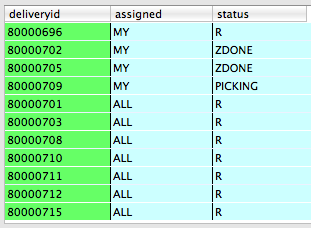It will be helpful to go through Previous tutorial before reading this one.
LINK
Now, we will change the structure of Vertex a little. Position array is now of size 3 to handle x, y as well as z.
struct Vertex {
float Position[3];
float Color[4];
};
Our rotation matrix
void ApplyRotationX(float degrees)
{
float radians = degrees * 3.14159f / 180.0f;
float s = std::sin(radians);
float c = std::cos(radians);
float zRotation[16] = {
1, 0, 0, 0,
0, c, s, 0,
0, -s, c, 0,
0, 0, 0, 1
};
GLint modelviewUniform = glGetUniformLocation(buildProgram, "Modelview");
glUniformMatrix4fv(modelviewUniform, 1, 0, &zRotation[0]);
}
void ApplyRotationY(float degrees)
{
float radians = degrees * 3.14159f / 180.0f;
float s = std::sin(radians);
float c = std::cos(radians);
float zRotation[16] = {
s, 0, c, 0,
0, 1, 0, 0,
c, 0, -s, 0,
0, 0, 0, 1
};
GLint modelviewUniform = glGetUniformLocation(buildProgram, "Modelview");
glUniformMatrix4fv(modelviewUniform, 1, 0, &zRotation[0]);
}
void ApplyRotationXY(float degrees)
{
float radians = degrees * 3.14159f / 180.0f;
float s = std::sin(radians);
float c = std::cos(radians);
float zRotation[16] = {
s, 0, c, 0,
s*c, c, -s* s, 0,
c*c, -s, -c * s, 0,
0, 0, 0, 1
};
GLint modelviewUniform = glGetUniformLocation(buildProgram, "Modelview");
glUniformMatrix4fv(modelviewUniform, 1, 0, &zRotation[0]);
}
Arrays of vertex and indices
// Define the positions and colors(R,G,B,A) of 8 vertices of square.
const Vertex Vertices[] = {
{{0, 0, 0}, {1, 0, 0, 1}},
{{0, 0.5, 0}, {0, 1, 0, 1}},
{{0.5, 0.5, 0}, {1, 1, 0, 1}},
{{0.5, 0, 0}, {1, 0, 1, 1}},
{{0, 0, 0.5}, {0, 1, 1, 1}},
{{0, 0.5, 0.5}, {0, 0.5, 0, 1}},
{{0.5, 0.5, 0.5}, {0.5, 0.5, 0, 1}},
{{0.5, 0, 0.5}, {0.5, 0, 0.5, 1}},
};
//Define the order of vertices for 12 triangles/
//0,1,2 forms first triangle
//2,3,0 form second triangle.
const GLubyte Indices[] = {
0, 1, 2,
2, 3, 0,
4,5,6,
6,7,4,
0,1,4,
1,4,5,
1,2,6,
1,5,6,
2,3,6,
3,6,7,
0,3,4,
3,4,7,
};
And finally drawing
// Drawing code
glClearColor(1.0f, 1.0f, 1.0f, 1);
glClear(GL_COLOR_BUFFER_BIT);
switch (rotateAlong) {
case 1:
ApplyRotationX(degreesX);
break;
case 2:ApplyRotationY(degreesY);
break;
default:ApplyRotation(degreesZ);
break;
}
glEnableVertexAttribArray(_positionSlot);
glEnableVertexAttribArray(_colorSlot);
//Lets give these functions pointer to head of vertex array.
GLsizei stride = sizeof(Vertex);
const GLvoid* pCoords = &Vertices[0].Position[0];
const GLvoid* pColors = &Vertices[0].Color[0];
//Attribute changed from 2 (when we had drawn square) to 3 (dealing with cube x,y and z)
glVertexAttribPointer(_positionSlot, 3, GL_FLOAT, GL_FALSE, stride, pCoords);
glVertexAttribPointer(_colorSlot, 4, GL_FLOAT, GL_FALSE, stride, pColors);
//Draw the 12 triangles and (12*3=)36 indices.
const GLvoid* bodyIndices = &Indices[0];
glDrawElements(GL_TRIANGLES,12* 3, GL_UNSIGNED_BYTE, bodyIndices);
glDisableVertexAttribArray(_positionSlot);
glDisableVertexAttribArray(_colorSlot);
[mimContext presentRenderbuffer:GL_RENDERBUFFER];
In order to know about rotation matrix, read this
LINK
It tells you about matrix used for rotation around x, y and z axis. For rotation around X as well Y (mixed rotation) we just multiply rotation matrix of X and Y axis.
There are 3 sliders with which you can rotate the cube along X, Y and Z axis.
//Solo Rotation along either of X,Y or Z.
switch (rotateAlong) {
case 1:
ApplyRotationX(degreesX);
break;
case 2:ApplyRotationY(degreesY);
break;
default:ApplyRotation(degreesZ);
break;
}
//Comment above lines in switch in code
//Uncomment following lines to see mixed rotation.
//Mixed Rotation along X and Y
ApplyRotationXY(40);
Check out screenshot:
You can download the code
HERE














